 |
Home | Charity | Feedback |
Peru:
Cusco,
Lima,
Machu Picchu,
Puno
Cusco, Peru: Capital of the Incas by Prakash Bang, Editor in Chief 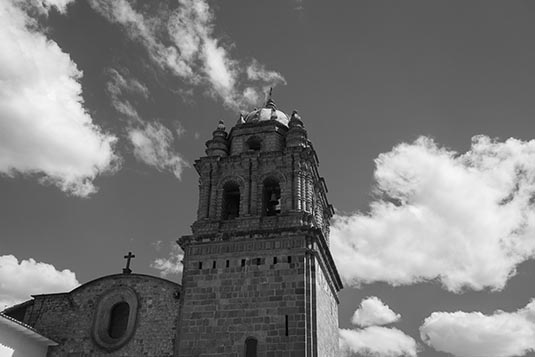 Cusco was long an important centre of indigenous people. It was the capital of the Inca Empire from the 13th until the 16th century Spanish conquest. Many believe that the city was planned as an effigy in the shape of a puma, a sacred animal. The Constitution of Peru designates Cusco as the Historical Capital of Peru. 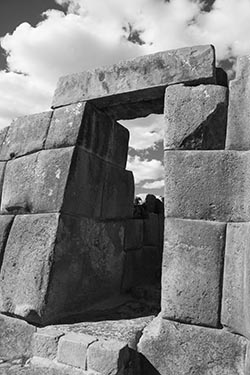 Cusco was the hub for the Spanish colonization and spread of Christianity in the Andean world. It became very prosperous thanks to agriculture, cattle raising and mining, as well as its trade with Spain. The Spanish colonists constructed many churches and convents, as well as a cathedral, university and Archbishopric.
Cusco was the hub for the Spanish colonization and spread of Christianity in the Andean world. It became very prosperous thanks to agriculture, cattle raising and mining, as well as its trade with Spain. The Spanish colonists constructed many churches and convents, as well as a cathedral, university and Archbishopric.
Our group landed in Cusco mid-morning. As was expected, a local guide was waiting to receive us at the airport. For our stay we were booked at Libertador Palacio del Inka Hotel which was right across the famous Cathedral of Cusco. Since buses and big vehicles were not allowed on the street leading to the hotel, we had to walk a block, through a pretty cobbled street to reach the palatial hotel. Cusco is at an elevation of 3800 metres. We were therefore warned about altitude sickness. Few of the members in our group took anti-sickness tablets just to be on the safer side. Thankfully, all was well with everybody. Those visitors having issues with high altitude, need to take it easy for a day or two after landing in Cusco. 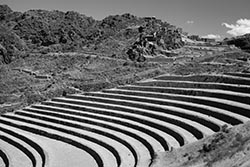 Palacio del Inka, a Luxury Collection Hotel, is built within an historic mansion known as the Casona de los Cuatro Bustos, which, from its privileged position next to Qoricancha Palace in the center of Cusco, has lived over five centuries of this storied city’s history. Each of the hotel's 203 guest rooms are exquisitely decorated with colonial art and furniture. Some rooms have Quechua names and Cusco School paintings decorate the walls, while the headboards and ceilings bear original hand-painted frescoes. The courtyard within the hotel is indeed a nice place to enjoy meals.
Palacio del Inka, a Luxury Collection Hotel, is built within an historic mansion known as the Casona de los Cuatro Bustos, which, from its privileged position next to Qoricancha Palace in the center of Cusco, has lived over five centuries of this storied city’s history. Each of the hotel's 203 guest rooms are exquisitely decorated with colonial art and furniture. Some rooms have Quechua names and Cusco School paintings decorate the walls, while the headboards and ceilings bear original hand-painted frescoes. The courtyard within the hotel is indeed a nice place to enjoy meals.
Post lunch, we commenced our tour which involved the visit to city's highlights located within and around. Our first stop was at Inca Ceremonial Centre of Sacsayhuaman. This enormous structure overlooks the city of Cusco. Its constructions are amazing with huge rocks perfectly fitted. It is said that over 10,000 workers toiled for 50 years to build it. For centuries it was thought that the structure was a fortress, but the layout and the architecture suggest a great sanctuary and temple of the sun which rises exactly opposite the place previously believed to be the Inca's throne. It's a good 30 minute uphill walk to reach the top of the site. From there you can get panoramic views of Cusco city. 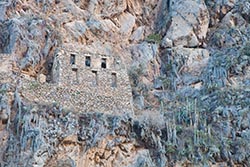 The tourism department has a kind of a pass (Boleto Turistico Del Cusco) for tourists that allows entry into many historical sites. I believe the cost of sol 130 (1 USD was about 3.3 sol) is well worth it.
The tourism department has a kind of a pass (Boleto Turistico Del Cusco) for tourists that allows entry into many historical sites. I believe the cost of sol 130 (1 USD was about 3.3 sol) is well worth it.
Our next stop was Qenqo. In Quechua language, Qenqo means labyrinth or zig-zag and the temple is named for the crooked canal cut out of its rock. Although it is clear the canal carried some sort of liquid, researchers have been forced to guess at its purpose, and at what liquid it transported. Hypotheses range from carrying holy water, chicha (corn beer), or blood. All three indicate that Qenqo was used for death rituals, possibly to embalm bodies or detect whether a person lived a good life by the course the liquid followed. 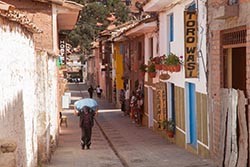 Qenqo is a unique temple in its construction as well, having been entirely carved out of a gigantic monolith. Stretched across a hillside, the temple is carved out of rock and marries the man-made tunnels with natural chambers. One of these chambers features 19 small niches and is set up as an amphitheater. Once again, the purpose of the theater has been lost over time, but most agree the area was used for some type of sacrifice to the sun, moon and star gods who were worshipped at the site.
Qenqo is a unique temple in its construction as well, having been entirely carved out of a gigantic monolith. Stretched across a hillside, the temple is carved out of rock and marries the man-made tunnels with natural chambers. One of these chambers features 19 small niches and is set up as an amphitheater. Once again, the purpose of the theater has been lost over time, but most agree the area was used for some type of sacrifice to the sun, moon and star gods who were worshipped at the site.
From the information available, it appears Qenqo Temple was an extremely holy site for the Incas. Their dead were judged and possibly embalmed in Qenqo’s winding tunnels, and blood sacrifices were offered to the heavenly gods. 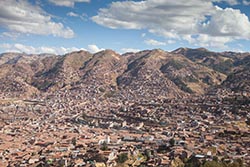 Next Inca site on our map was Tambomachay - a temple dedicated to the God of Water. It is believed that the Incas have used this complex for religious ceremonies either directly dedicated to the water's worshipping or for other rituals that included the use of flowing water.
Next Inca site on our map was Tambomachay - a temple dedicated to the God of Water. It is believed that the Incas have used this complex for religious ceremonies either directly dedicated to the water's worshipping or for other rituals that included the use of flowing water.
Specialists call Tambomachay a "royal bath". The Inca ruler periodically visited Tambomachay and the other, nearby site of Puca Pucara. During these repeated visits, his followers would stay at Puca Pucara, while the great leader would stay at Tambomachay with only his closest followers, family members and personal guards. 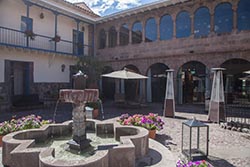 The Tambomachay site is composed of a liturgical fountain and 3 terraces. The structure has 3 levels and, as it was common among Inca buildings, this one too had been built with perfectly fitting-together unequal-shaped bricks without the usage of mortar. Even after many centuries, the stones look well-polished and strongly stick to one another. At Tambomachay there are 2 fountains that constantly function, at any time of the year. The source of the flowing crystal clear water remains unknown.
The Tambomachay site is composed of a liturgical fountain and 3 terraces. The structure has 3 levels and, as it was common among Inca buildings, this one too had been built with perfectly fitting-together unequal-shaped bricks without the usage of mortar. Even after many centuries, the stones look well-polished and strongly stick to one another. At Tambomachay there are 2 fountains that constantly function, at any time of the year. The source of the flowing crystal clear water remains unknown.
We returned back to town to visit Inca’s most sacred building – The Temple of Qoricancha. Believed to have been built around 1200 AD, the temple was constructed using the distinctive and intricate masonry style of the Incas. The temple cemented the symbolic importance of religion in uniting the divergent cultural practices. 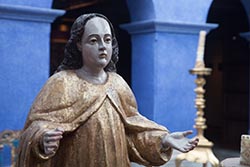 As well as housing more than 4,000 priests, the positioning of the temple in relation to the nearby Andes mountains meant that Qoricancha functioned as an enormous calendar. Shadows cast by stones placed on the foothills could be seen from the temple, marking out the solstice and equinoxes observed by the Incan empire.
As well as housing more than 4,000 priests, the positioning of the temple in relation to the nearby Andes mountains meant that Qoricancha functioned as an enormous calendar. Shadows cast by stones placed on the foothills could be seen from the temple, marking out the solstice and equinoxes observed by the Incan empire.
The temple complex consisted of four main chambers, each dedicated to a different deity of the moon, stars, thunder and rainbows. Much of Qoricancha was filled with gold, with one chamber containing a giant sun disc, reflecting sunlight that illuminated the rest of the temple. The disc was aligned so that during the summer solstice it illuminated a sacred space where only the emperor himself was allowed to sit. 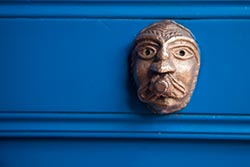 Our last visit was to the massive and beautiful Cathedral of Cusco.
Our last visit was to the massive and beautiful Cathedral of Cusco.
The Cathedral of Cusco or the Basilica Cathedral of the Virgin of Asuncion is the main temple and Christian religious monument. It was built on the spot where Suntur Wasi, a house of weapons and shields of the Incas was. Nowadays, on top of these two primitive buildings stand the Cathedral and the two smaller churches. In the period of the conquest, the Ecclesiastical Council of the city ordered the demolition and relocation of andesite stones of the main walls of the fortress of Sacsayhuaman for the construction of the cathedral between 1560 and 1664. Although the building was designed and supervised by architects and Hispanic priests, the labour was executed with the sweat, tears and blood of the Incas. 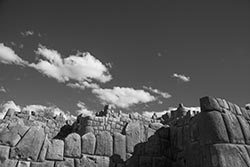 As evidence of it, the traveler can see when visiting the Cathedral, the large blocks of red granite taken from the Inca fortress of Sacsayhuaman. The building is one of the most impressive of the city, its renaissance facade contrasts with the mud and silver of its luxurious interiors. It also has one of the most important goldsmith samples of colonial art, engraved wooden altars and a beautiful collection of paintings from the Cusco School.
As evidence of it, the traveler can see when visiting the Cathedral, the large blocks of red granite taken from the Inca fortress of Sacsayhuaman. The building is one of the most impressive of the city, its renaissance facade contrasts with the mud and silver of its luxurious interiors. It also has one of the most important goldsmith samples of colonial art, engraved wooden altars and a beautiful collection of paintings from the Cusco School.
The construction of this cathedral took 132 years. It was built on an area of over 4000 sq.mtrs., it has eleven chapels, one vestry, one chapter house, seven altarpieces and one choir under fully carved in cedar wood. The Cathedral, also, has over 300 paintings, various carvings and sculptures. 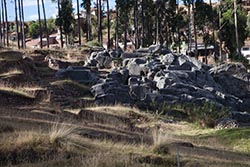 The next morning, after breakfast we were ready to leave the town of Cusco to drive through Sacred Valley, Pisac and Ollantaytambo.
The next morning, after breakfast we were ready to leave the town of Cusco to drive through Sacred Valley, Pisac and Ollantaytambo.
The Sacred Valley of the Incas was undoubtedly a key area of settlement to the Incas. Its agreeable climate and fertile plains make a rare and fruitful combination for the high Andes. It was also the route to the jungle and therefore an area with access to the fruits and plants of the tropical lowlands. The Sacred Valley served as a buffer zone, protecting Cusco from incursions of the Antis, the fierce jungle tribes who from time to time raided the highlands. Today the Sacred Valley remains a lush agricultural region supplying the city of Cusco with much of its produce such as maize, fruit and vegetables. 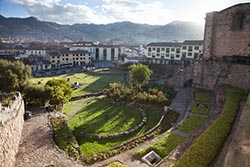 A vital Inca road once snaked its way up the canyon that enters the Urubamba Valley at Pisac. The citadel, at the entrance to this gorge, now in ruins, controlled a route which connected the Inca Empire with Paucartambo, on the border of the eastern jungles. Set high above a valley floor patch-worked by patterned fields and rimmed by vast terracing, the stonework and panoramas at Pisac's Inca citadel are magnificent. Terraces, water ducts and steps have been cut out of solid rock, and in the upper sector of the ruins is the main Sun Temple. Above the temple are more ruins, mostly unexcavated. Among the higher crevices and rocky overhangs several ancient burial sites.
A vital Inca road once snaked its way up the canyon that enters the Urubamba Valley at Pisac. The citadel, at the entrance to this gorge, now in ruins, controlled a route which connected the Inca Empire with Paucartambo, on the border of the eastern jungles. Set high above a valley floor patch-worked by patterned fields and rimmed by vast terracing, the stonework and panoramas at Pisac's Inca citadel are magnificent. Terraces, water ducts and steps have been cut out of solid rock, and in the upper sector of the ruins is the main Sun Temple. Above the temple are more ruins, mostly unexcavated. Among the higher crevices and rocky overhangs several ancient burial sites.
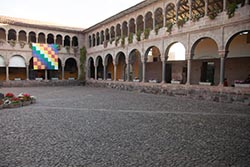 At the foothills, modern Pisac is a picturesque Andean Village. The village is best known for its Sunday market, which draws hundreds of tourists each week. In spite of its popularity the market retains much of its local charm, at least in the part where villagers from miles around gather to barter and sell their produce. It was a nice place for souvenir shopping (especially handicrafts made of silver) and to have lunch in one of its many restaurants.
At the foothills, modern Pisac is a picturesque Andean Village. The village is best known for its Sunday market, which draws hundreds of tourists each week. In spite of its popularity the market retains much of its local charm, at least in the part where villagers from miles around gather to barter and sell their produce. It was a nice place for souvenir shopping (especially handicrafts made of silver) and to have lunch in one of its many restaurants.
Ollantaytambo is an attractive little town located at the western end of the Sacred Valley. The town has been built on top of original Inca foundations and is the best surviving example of Inca town planning. The town is divided in canchas (blocks) which are almost entirely intact. Each cancha has only one entrance (usually a huge stone doorway) which leads into a central courtyard. The houses surround the courtyard. 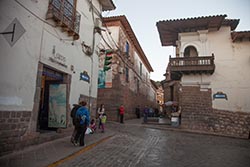 The town is located at the foot of some spectacular Inca ruins. The temple area is at the top of steep terracing which helped to provide excellent defences. Stone used for these buildings was brought from a quarry high up on the opposite side of the Urubamba River - an incredible feat involving the efforts of thousands of workers. The complex was still under construction at the time of the conquest and was never completed.
The town is located at the foot of some spectacular Inca ruins. The temple area is at the top of steep terracing which helped to provide excellent defences. Stone used for these buildings was brought from a quarry high up on the opposite side of the Urubamba River - an incredible feat involving the efforts of thousands of workers. The complex was still under construction at the time of the conquest and was never completed.
After Manco Inca was defeated by the Spanish at Sacsayhuaman following the unsuccessful siege of Cusco in 1536, he retreated to Ollantaytambo. Francisco Pizarro's younger brother Hernando led a force of 70 cavalry, 30 foot soldiers and a large contingent of natives to capture Manco Inca. The Inca's forces, joined by neighbouring jungle tribes, rained down showers of arrows, spears and rocks upon the unfortunate Spanish troops. In an intelligent move the Incas flooded the plains below their stronghold making it difficult for the horses to manoeuvre. Hernando, uncharacteristically, ordered a hasty retreat. Ollantaytambo became the only place ever to have resisted attacks from the Spanish. However, their victory was short-lived when the Spanish returned with four times their previous force. Manco Inca retreated to his jungle stronghold in Vilcabamba and Ollantaytambo fell into the hands of the Spanish. 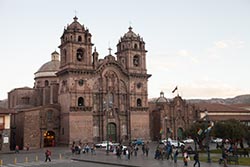 It was now time for us to head to the railway station to board the Expedition Train to Aguas Calientes, a modern little town close to the sanctuary of Machu Picchu. After passing the Sacred Valley of the Incas, the train starts to descend gradually along the edge of the Urubamba River. In an hour and 45 minutes we were at Aguas Calientes - the base station to explore Machu Picchu - another highlight of our South American trip.
It was now time for us to head to the railway station to board the Expedition Train to Aguas Calientes, a modern little town close to the sanctuary of Machu Picchu. After passing the Sacred Valley of the Incas, the train starts to descend gradually along the edge of the Urubamba River. In an hour and 45 minutes we were at Aguas Calientes - the base station to explore Machu Picchu - another highlight of our South American trip.
Cusco Image Gallery  Photo viewer Photo viewer
|
|
|
Home |
Charity |
Feedback
Privacy Policy | Terms of Usage © YoGoYo.com. All rights reserved. |

































































